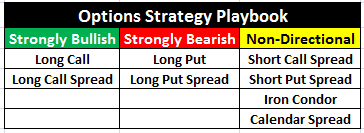How Options Trading Works
Traders are often times intimidated by options initially because of the terminology and a lack of understanding of how to use the products. While there many different ways of using these products, the key is to not over think things. They are just another instrument that you can use to act on your market outlook. Just like any other style of trading, it is important to have a roadmap in place that you can follow throughout the trade. Let’s walk through some of the basics.
The most important factor in becoming successful with options is to make sure you are using the correct strategy that best matches your outlook on the product. Most traders come into options trading thinking if they are bullish on a stock they can just buy a cheap call option. If they are bearish they just need to buy a cheap put option. They buy the option that fits their account size instead of picking one that fits their market outlook. To put the odds in your favor on a bullish or bearish outlook you are much better off using In-the-Money options as opposed to Out-of-the-Money options. If you are looking to trade single options then a good place to start is to buy options that are at least one strike in the money.
Of course we like to use directional systems in the Premier Trader University so those systems print the road map for us. If the system gives us an edge in determining market direction, then we are just taking it a step further and deciding to play the options instead of the shares of stock. Regardless of how you form your market outlook, the next step is to choose the correct options strategy. If you are bullish a good place to start is to look at using a long call or long call spread. If you are bearish then you would be looking at a long put or long put spread.
If you are looking at a product that you are a little unsure of direction on then you can also consider collecting premium by selling options to open a position. Some common strategies that you can use for this outlook include short Call and Cut Spreads, Iron Condors or Calendar Spreads. When using these types of trades you are trying to take advantage of time decay and a decrease in implied volatility.
Where traders get hung up when initially trading options is knowing how to manage a trade. If you are placing a direction trade, whether that be up or down, then it really helps to have a system in place that gives you defined targets and stops. With the PTU Options Mastery Course we use the Active Swing Trader System which gives us those defined targets and stops. When the stock or ETF hits that specific target or stop then we go in and exit our options position. We don’t manage the trade by using the options price we manage the trade using the price of the stock. This takes a lot of the confusion out of the equation.
If you are using a non-directional strategy by selling premium, then it is a good idea to manage the trade according to your outlook. If your outlook changes on the stock or ETF that you are trading then adjust your position accordingly. A typical rule that I use for myself is to get out of these types of trades when we can book between 50-75% of the maximum potential profit.
Don’t over think the options space. You can place these trades and manage them very easily as long as you have a roadmap in place to follow. Yes, options have more moving parts than the shares of stock but that doesn’t mean you have to complicate things in order to be successful. Plan your trade and then trade your plan.
